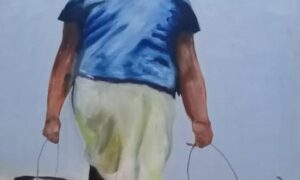Poetry, perhaps one of the oldest genres of literature, transcends history and philosophy. As Sir Philip Sidney in his Defence of Poesy illustrates that it must be revered for its antiquity. The poet being an emotional custodian of the art and culture reinvents history through his language. Lahore, I am Coming is Rizwan Akhtar’s first collection of poems, and most of the poems reverberate the past civilization of the subcontinent, the Moghul art and architecture, culture and geography. It also echoes the ravages of colonialism on culture and traditions of the sub-continent. The inclusion of the images of various places of Lahore particularly Moghul art and architecture reflects his belongings and association with Lahore.
As the title suggests, it seems that the poet is an exotic address the city about his coming. In his poems, history like language is everywhere. Akhtar’s poetry encapsulates the sense of rich Moghul art. He makes a lot of allusions to Moghul art and architecture in his poetry, like The Royal Mosque and behind it The Dancing Girls’ Bazar, Kamran’s Bara Dari, Moghul’s prisons inside the Fort, and most of the significant places of the city like mentioning of Mall Road, Zamzama, Oriental College, Lawrence Gardens and The Lahore Fort, and also an allusion of Warish Shah’s Heer. The poet uses these allusions to revitalize the history as the past burst in suddenly in the present, seems that something is really thereby not creating the feelings of hallucination. The poet enters the courtyard of the Badshahi Mosque and what he sees, the past reveals before his eyes:
I entered the courtyard of the Badshahi Mosque
See Moghuls sleeping on pillows made of Ghazals

The city becomes the epiphany for the poet who seeks inspiration for writing poetry. Everything from the Moghul architecture sprouts language, rhythm, so germinate poetry. Poetry is in the bone marrow of the city. The city becomes the poet’s beloved, for everything becomes music, language, and history either it is a raqasa or ajars, or the fallen leaves of the trees, as “leaves fall slowly as alphabets struggle on a plate growing distant stories”. His language expresses rich and subtle meanings. The rhythmic structure of the Dancing Bazar produces a musicality in the environment composing a ghazal. The ghazal, language, emerges from the rhythm of the dancer’s feet – a wavy motion. The raqasa’s dance is reminiscent of the long-forgotten luster of the Moghul court delighting the beholder. The representation of art through various images has an aesthetic effect which is the beauty of works of art.
The sense of longing and belonging, and sense of loss are the common themes along with other subject matters. Here, the poet feels a sense of loss of this kotha (residence of courtesans during Moghul Empire) culture that is permanently taken from us by the colonizers, a harsh consequence of colonialism in destroying subcontinent’s culture.
As poets are the unacknowledged legislators of the world, so Akhtar feels this sense of loss with sensitivity. There is originality of metaphors and similes in Akhtar’s poetry like “Lahore is absolutely unaware of the germs of poems, so many of them like sluggish sperm waste inside ovaries of suspicion”. There is a sharp comparison between ‘the germs of poems’ and ‘the sluggish sperms’. Both are the genesis of creation. It illustrates Lahore as a custodian – a city that is holding language and culture. The use of Urduized-English words (transliteration) such as “verandah, raqasa, Molvi, milky lasi, Mohalla, tasbih, Kurta, chai wala, gaachi, desi, etc.” depicts the rich language and rich culture. Akhtar, a distinctive emerging poet in the English language, introduces words from Urdu, Persian, and Arabic, in his poems establishing his own identity, as the word raqasa has a complete history of Moghul era in it. The purpose of the inclusion of words from Urdu, Persian, and Arabic in his poems is to rediscover the cultural past lost in the colonial era. The remembrance of the past and bringing it into his poetry is considered an act of resistance against the colonizers.
In Akhtar’s poems, everything is represented as text that has something to communicate, the buildings, the roads, the trees as
Trees are like extinct languages
Taking care of their lonely lives
Wind spatters leaves curling verbosely
On ground holding archaic texts
You did not read my gestures
They are sprouting like poems.
Language sprouts from each and everything of this city, such is the connection between the text and the language that is very subtle in Akthar’s poetry like “dark flooding roads like pages”, “last time we met the sea boiled over your sweltering tongue, monosyllabic”, “languages floating on seas”. The poet uses his words in such a way as a farmer scatter seeds in the field and plants grow from those saplings, similarly, the poet’s use of diction creates a new language – an idiom of his own, as
My alphabets are singlehandedly sown in this city.
A new language emerges from my silence.”
Akhtar uses language in his poetry in such a way that the text and the form seem like a female entity – the words and syllables dance on the pages, like “my fingers dance to a dervish’s manuscript”. Dance, raqas and dhamal have a close association with mysticism as mentioned in the poem “The Mystic Dancers of Punjab”. The poet unconsciously jumps into the past and lost into mystic thoughts, and such mystic romance takes the readers back to the past – pre-partition era. It also elaborates the concept of mysticism which was a significant part of Muslims’ identity in the subcontinent. The description of raqasa is a revisit of the past – the nostalgic feelings that act as a flashback of the Dancing Bazar – the kotha culture which was destroyed at the hand of the colonizers. The poet has an emotional attachment with his culture, and also with the city. So the poet seems to reinvent history through his language and poems.
In his long poem, ‘Lahore, I am Coming’ the poet shows his belonging with the city – a lover-beloved spiritual relationship illustrated through meditation and self-surrender,
Lahore I am in love with you.
I am yours, Lahore
I am also your prisoner.
Such is the hypnotizing effect of this relationship – the height of self-surrendering. Remembering the past, the poet lost in his childhood in the streets of the city. The ecstasy in this communion comes through contemplation that sounds as the poet wants a mystical union. The poet is fascinated and spellbound with the city streets where he spent his childhood wandering lonely, playing the games; the city “descends with its smells’ that carry the poet’s childhood stories. Many other poems such as “Lahore Evenings, The Lahore Fort, Rain-script: Lahore 2013 illustrate the rich culture of the city, where the trees “pruned by colonial fantasies, and “stand like arrogant histories”, the colonizers who even “colonize our shrubs” pruned the history, culture, and tradition like the pruning of trees. Such is the destruction done by the invaders. When the poet visits the historical and culturally rich places of the city, he is captivated by the alluring beauty, pre-colonial glorious past of the city which was ravened by the colonizers. The mesmerizing culture of the city’s art and architecture has long-lasting effects on Akhtar’s mind and they descend as an intuition that becomes the Muse – a source of inspiration for the poet.
Book: Lahore, I am Coming
Author: Dr. Rizwan Akhtar
Total Pages: 220
Price: 500 PKR
ISBN No. 9789699325410
Publisher: Department of Press & Publication, University of the Punjab, Lahore



















